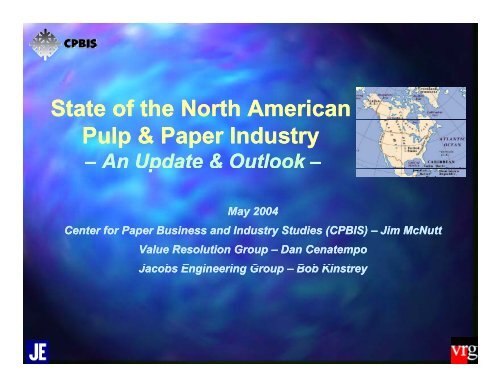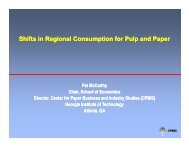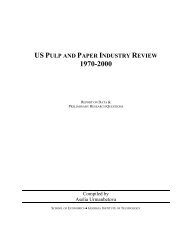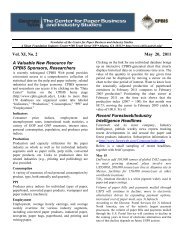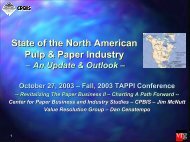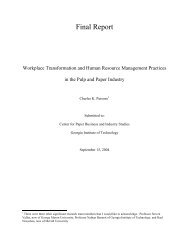State of the North American Pulp & Paper Industry - The Center for ...
State of the North American Pulp & Paper Industry - The Center for ...
State of the North American Pulp & Paper Industry - The Center for ...
Create successful ePaper yourself
Turn your PDF publications into a flip-book with our unique Google optimized e-Paper software.
<strong>State</strong> <strong>of</strong> <strong>the</strong> <strong>North</strong> <strong>American</strong><br />
<strong>Pulp</strong> & <strong>Paper</strong> <strong>Industry</strong><br />
– An Update & Outlook –<br />
May 2004<br />
<strong>Center</strong> <strong>for</strong> <strong>Paper</strong> Business and <strong>Industry</strong> Studies (CPBIS) – Jim McNutt<br />
Value Resolution Group – Dan Cenatempo<br />
Jacobs Engineering i Group – Bob Kinstrey
Overview<br />
<strong>North</strong> America P&P <strong>Industry</strong><br />
– An Update & Outlook –<br />
• Where Are We?<br />
• <strong>Industry</strong> Per<strong>for</strong>mance<br />
• Capacity Issues<br />
• <strong>Industry</strong> Outlook<br />
• Grades’ Outlook -- Grade-By<br />
By-Grade<br />
• Major <strong>Industry</strong> Issues<br />
• Summary & Wrap-up<br />
2
Where Are We?<br />
3
What Are <strong>North</strong> America’s? –<br />
Stakeholders’ Perspectives<br />
• Has Persistent Flaws in <strong>the</strong> Eyes <strong>of</strong> Many<br />
Capital Intensive, fragmented, , technology<br />
based – monolithic & slow to adapt<br />
Focus is more on what it does instead <strong>of</strong><br />
figuring out what it should be doing<br />
Key into lower costs, economies <strong>of</strong> scale,<br />
market share, marginal returns<br />
Very open in<strong>for</strong>mation flows<br />
Highly insular<br />
4
What Is <strong>North</strong> America’s –<br />
Market Perspective?<br />
• <strong>The</strong> <strong>North</strong> <strong>American</strong> <strong>Pulp</strong> and <strong>Paper</strong> <strong>Industry</strong> Is Mature<br />
Web <strong>of</strong> Businesses Generally Characterized <strong>of</strong> Late By:<br />
<br />
<br />
<br />
<br />
<br />
<br />
<br />
Highest per capita consumption in world across all grades<br />
Slower growth than GDP & slowing overall GDP growth<br />
High capital intensity<br />
Intense Cost and price based competition<br />
Cyclical and declining pricing and pr<strong>of</strong>itability<br />
Below cost <strong>of</strong> capital returns<br />
Depressed investors’ values and returns<br />
Where Historically – <strong>The</strong> <strong>North</strong> <strong>American</strong> industry<br />
has expanded after each cyclical peak. Excess<br />
capacity was pushed into International Markets<br />
5
What Is <strong>North</strong> America’s –<br />
Market Perspective?<br />
• However – Looking Back – Combination Of –<br />
A strong US dollar;<br />
Maturing <strong>North</strong> <strong>American</strong> Demand;<br />
Unifying European markets;<br />
Aggressive industry growth in developing regions<br />
-- Asia & Latin America; ; and<br />
<strong>The</strong> European & Developing Regions ‘new’<br />
producers increased imports into <strong>North</strong> America -<br />
- Interrupted This Growth Pattern<br />
6
What Is <strong>North</strong> America’s –<br />
Market Perspective?<br />
• However<br />
-- <strong>The</strong> <strong>North</strong> <strong>American</strong> <strong>Industry</strong> Did Not<br />
Recognize This Competitive Landscape Change<br />
Until Mid 1990s and --<br />
Continued to behave as it did in <strong>the</strong> past – investing<br />
available cash in new capacity in 1980’s & early<br />
1990s<br />
• This New Capacity Relied on Increasingly<br />
Competitive Export Markets to Maintain Volume<br />
• Yet – Simultaneously -- Developing Regions &<br />
Europe Began Aggressive Imports into <strong>North</strong><br />
America.<br />
7
What Is <strong>North</strong> America’s –<br />
Market Perspective?<br />
<strong>The</strong> Result Was Persistent Over-capacity,<br />
Globalization <strong>of</strong> Markets -- Which Undermined &<br />
Sustained Weak Balance a Sheets, Debt Levels,<br />
e Pricing, Pr<strong>of</strong>itability & Shareholder Returns<br />
In response – <strong>The</strong> <strong>North</strong> <strong>American</strong> <strong>Industry</strong> has now<br />
begun to restructure to better compete in this changed<br />
global market environment – but <strong>the</strong> challenges and<br />
stakes are great and <strong>the</strong> progress moderate.<br />
8
What Are <strong>North</strong> America’s –<br />
Current Realities?<br />
• <strong>North</strong> America’s <strong>Paper</strong> <strong>Industry</strong> Pressures Continue<br />
CEOs remain under <strong>the</strong> microscope<br />
Per<strong>for</strong>mance continues to lag<br />
lag – but seeming to stabilize some<br />
Excess Capacity & older/inefficient technology being addressed<br />
Substitution (imports & alternative products to meet consumers<br />
needs) = persistent issue<br />
Balance sheets still out <strong>of</strong> balance – with moves to improve<br />
Reinvestment in revenue generation steps continues to lag<br />
Competitive landscape remains Intense – some order emerging<br />
Let’s Now Look at some <strong>of</strong> <strong>the</strong> Situational Aspects <strong>of</strong><br />
<strong>the</strong> US/NA <strong>Industry</strong> & Discuss <strong>The</strong>ir Importance . . . .<br />
9
<strong>Industry</strong> Per<strong>for</strong>mance<br />
10
<strong>Industry</strong> Per<strong>for</strong>mance<br />
–<br />
ROTC Vs. Cost <strong>of</strong> Capital<br />
Cost <strong>of</strong> Capi ital<br />
Return &<br />
20%<br />
15%<br />
10%<br />
5%<br />
ROTC averages 7% vs.<br />
ROTC Averages 7 % vs.<br />
11% cost <strong>of</strong> capital<br />
11% Cost <strong>of</strong> Capital<br />
0%<br />
1975 1978 1981 1984 1987 1990 1993 1996 1999 2002<br />
Return On Total Capital<br />
Cost <strong>of</strong> Capital<br />
Returns<br />
Average 4<br />
Points Below<br />
Target --<br />
Rational<br />
Investors Will<br />
Not Allocate<br />
Capital To <strong>The</strong><br />
Poorly<br />
Per<strong>for</strong>ming<br />
Sector & Firms<br />
11
Monthly To otal Sharehold der Return (TS SR) Index<br />
<strong>Industry</strong> Per<strong>for</strong>mance -- Total<br />
Shareholder Returns Still Trail S&P 500<br />
400<br />
350<br />
300<br />
250<br />
200<br />
150<br />
100<br />
50<br />
P&FP Shareholder<br />
Risk <strong>of</strong> P&FP Stocks = Market (Beta = 1.0)<br />
S&P 500 TSR = 10.3% Per Year<br />
Returns Have<br />
P&FP W. Avg TSR = 8.5% Per Year<br />
P&FP Avg. TSR = 7.5% Per Year Trailed S&P 500<br />
L.T. Government Bond = 6.2% Per Year<br />
0<br />
'92 '93 '94 '95 '96 '97 '98 '99 '00 '01 '02 '03<br />
S&P Return Index P&FP Company Avg. P&FP Company W. Avg.<br />
Yet -- Stocks<br />
Rebounding With<br />
Overall Market<br />
Investment<br />
Services Don’t<br />
Expect Full P&P<br />
Earnings Rebound<br />
Until 2004<br />
12
<strong>Industry</strong> Per<strong>for</strong>mance – Debt Levels<br />
Debt To Capital Ratio<br />
70%<br />
60%<br />
50%<br />
40%<br />
30%<br />
20%<br />
1975 1978 1981 1984 1987 1990 1993 1996 1999 2002<br />
Debt % <strong>of</strong> Invested Capital<br />
US Companies<br />
Are<br />
Maintaining<br />
Debt Levels<br />
Near 50% -<br />
Which Will<br />
Likely Limit<br />
Future<br />
Investments<br />
13
<strong>Industry</strong> Per<strong>for</strong>mance – Capital<br />
Spending Level – Real USD<br />
U.S. Rea al Capital Exp penditures ($ $2002 -<br />
Millio ons)<br />
15,000<br />
12,500<br />
10,000<br />
7,500<br />
5,000<br />
2,500<br />
-<br />
Total<br />
1975 1978 1981 1984 1987 1990 1993 1996 1999 2002<br />
US <strong>Pulp</strong> &<br />
<strong>Paper</strong> Capital<br />
Expenditures<br />
Will Continue<br />
To Languish<br />
Until <strong>The</strong><br />
Cyclical<br />
Recovery<br />
Total<br />
Circa 2004<br />
14
<strong>Industry</strong> Per<strong>for</strong>mance – Less Capital Being<br />
Invested In Primary <strong>Industry</strong> Assets<br />
Sh hare <strong>of</strong> <strong>Pulp</strong> & <strong>Paper</strong> Capita al Spending<br />
100%<br />
90%<br />
80%<br />
70%<br />
60%<br />
50%<br />
40%<br />
30%<br />
20%<br />
10%<br />
0%<br />
1980 1982 1984 1986 1988 1990 1992 1994 1996 1998 2000<br />
IT & Communic. Facilities, Machinery & Infra. Office Buildings & Furnish.<br />
Facility<br />
Related<br />
Spending<br />
Accounts For<br />
Declining<br />
Share <strong>of</strong> P&P<br />
CAPEX <strong>for</strong><br />
IT = More<br />
15
<strong>Industry</strong> Per<strong>for</strong>mance – Pr<strong>of</strong>itability<br />
Net Operat ting Pr<strong>of</strong>it Margin<br />
12%<br />
10%<br />
8%<br />
6%<br />
4%<br />
2%<br />
0%<br />
1975 1978 1981 1984 1987 1990 1993 1996 1999 2002<br />
US <strong>Pulp</strong> &<br />
<strong>Paper</strong><br />
Pr<strong>of</strong>itability<br />
Continues Its<br />
Declining<br />
Path In Real<br />
Terms Since<br />
1970s<br />
16
<strong>Industry</strong> Per<strong>for</strong>mance – Capital Turnover<br />
Sales / Tota al Invested Capital<br />
200%<br />
180%<br />
160%<br />
140%<br />
120%<br />
100%<br />
80%<br />
1975 1978 1981 1984 1987 1990 1993 1996 1999 2002<br />
US <strong>Pulp</strong> &<br />
<strong>Paper</strong><br />
Capital<br />
Turnover To<br />
Continue Its<br />
Downward<br />
Trend<br />
17
es % <strong>of</strong> Dep preciation<br />
Capita al Expenditu<br />
275%<br />
250%<br />
225%<br />
200%<br />
175%<br />
150%<br />
125%<br />
100%<br />
75%<br />
<strong>Industry</strong> Per<strong>for</strong>mance – Capital<br />
Spending/Depreciation<br />
50%<br />
25%<br />
0%<br />
1975 1978 1981 1984 1987 1990 1993 1996 1999 2002<br />
US CAPEX<br />
Likely To<br />
Remain<br />
Significantly<br />
Below<br />
Depreciation<br />
Levels<br />
And Are Now<br />
Below<br />
Maintenance<br />
Levels<br />
18
Capacity Issues<br />
19
Capacity Issues – Major Trend Change<br />
U.S. Shipments Off 14% In 2003 From 1999 Peak<br />
<strong>Paper</strong>board<br />
(ST 000s)<br />
U.S. To otal <strong>Paper</strong> &<br />
110,000<br />
100,000<br />
90,000<br />
80,000<br />
70,000<br />
60,000<br />
50,000<br />
40,000<br />
30,000<br />
20,000<br />
10,000<br />
-<br />
1975 1978 1981 1984 1987 1990 1993 1996 1999 2002<br />
Capacity<br />
20<br />
Shipments
Capacity Issues – Declining NA Share<br />
<strong>Paper</strong> and <strong>Paper</strong>board Capacity<br />
(1,000 short tons)<br />
450,000<br />
400,000<br />
350,000<br />
300,000<br />
250,000 Worldwide<br />
200,000<br />
<strong>North</strong> America<br />
150,000<br />
100,000000<br />
50,000<br />
-<br />
21
Capacity Issues – Growth Outside NA<br />
Capacity Change 1995 to 2001<br />
120.0%<br />
100.0% 0%<br />
80.0%<br />
60.0% 0%<br />
40.0%<br />
Total <strong>Paper</strong> & <strong>Paper</strong>board<br />
Printing & Writing<br />
Wrapping & Packaging<br />
20.0% 0%<br />
0.0%<br />
World <strong>North</strong> Europe Asia + Latin<br />
America Japan America<br />
22
Capacity Issues – NA PM Changes<br />
Grade<br />
Shuts<br />
New<br />
Shuts<br />
New<br />
1980-8989 1980-8989 1990-0303 1990-0303<br />
News 5 19 7 8<br />
P & W 73 44 137 24<br />
Packaging &<br />
Converting<br />
44 2 56 10<br />
Tissue 46 30 70 39<br />
<strong>Paper</strong>board 44 17 77 34<br />
Construction<br />
<strong>Paper</strong> & Board<br />
94 2 11 2<br />
Total 306 114 358 114<br />
23
Capacity Issues – PM Age Distribution ib ti --<br />
<strong>North</strong> America vs. Europe<br />
450<br />
400<br />
Age Distribution ib ti <strong>of</strong> <strong>Paper</strong> Machines<br />
Economic<br />
350 Obsolescence<br />
Proxy<br />
300<br />
250<br />
200<br />
150<br />
100<br />
50<br />
0<br />
1890-<br />
1899<br />
1900-<br />
1909<br />
1910-<br />
1919<br />
1920-<br />
1929<br />
1930-<br />
1939<br />
1940-<br />
1949<br />
1950-<br />
1959<br />
1960-<br />
1969<br />
1970-<br />
1979<br />
1980-<br />
1989<br />
1990-<br />
1999<br />
2000-<br />
2003<br />
<strong>North</strong> America (1102) Europe (1861)<br />
24
<strong>Industry</strong> Outlook<br />
25
<strong>Industry</strong> Outlook – Market Overview<br />
• Weakness in <strong>the</strong> Economy & Demand Drivers -- Is<br />
Improving – Which Is Significant <strong>for</strong> <strong>Pulp</strong> & <strong>Paper</strong> <strong>Industry</strong><br />
• However, Weak Downstream Demand Past Two Years --<br />
Plus Range <strong>of</strong> Competitive Factors -- Did Result in<br />
Significant Excess Capacity & Inventories<br />
• This Excess Capacity [& Inventories] In Turn Undermined<br />
<strong>Pulp</strong> & <strong>Paper</strong> Prices & Returns – Which Although Improving<br />
-- Still Need More Correction<br />
<strong>The</strong> net result is persistent poor, but now<br />
improving per<strong>for</strong>mance, in <strong>the</strong> <strong>North</strong> <strong>American</strong> pulp<br />
& paper industry during <strong>the</strong> outlook period.<br />
26
<strong>Industry</strong> Outlook – <strong>The</strong> Economy<br />
Line Item 2003 2004-20062006<br />
US Real GDP<br />
Growth<br />
US Inflation<br />
(PPI Index)<br />
European Real<br />
GDP Growth<br />
European<br />
Inflation (GDP<br />
Deflator)<br />
2.2% 3.6%<br />
2.6% 0.7%<br />
1.3% 2.0%<br />
1.0% 0.4%<br />
Overall<br />
Economic<br />
Forecast Now<br />
Calls For<br />
Continued<br />
Recovery With<br />
US Leading<br />
Europe<br />
27
<strong>Industry</strong> Outlook<br />
– <strong>The</strong> Drivers<br />
Economic Segment<br />
Food & Beverage<br />
Restaurant / Recreation<br />
Durable Goods<br />
<strong>Industry</strong> Segment<br />
Impacted<br />
2001-<br />
2002 Real<br />
Growth<br />
Q2<br />
2003<br />
Real<br />
Growth<br />
vs. 2002<br />
Boxboard/Containerboard -2.0%<br />
+3.6%<br />
Boxboard, Tissue -3.0%<br />
+1.6%<br />
Containerboard -5.1%<br />
+8.2%<br />
Non-Durable Goods<br />
Containerboard -4.1%<br />
41% +3.3% 3%<br />
Computer & Peripheral<br />
Investment<br />
Advertising<br />
Housing Starts<br />
Private Investment<br />
P&W <strong>Paper</strong>s -11.5%<br />
+31.0%<br />
P&W & Newsprint -29.5%<br />
+6.8%<br />
Tissue, Forest Prods +5.7% +11.8%<br />
All Mfg. Industries incl. P&P -21.7%<br />
+8.0%<br />
Demand<br />
Growth<br />
Drivers<br />
Accelerating –<br />
Just Now<br />
+3 3% Being Realized<br />
By<br />
Manufacturing<br />
Sector<br />
Industrial Production<br />
All Mfg. Industries incl. P&P -4.0%<br />
0.0%<br />
28
<strong>Industry</strong> Outlook – Per<strong>for</strong>mance Direction<br />
Line Item<br />
2003 Sales<br />
Growth<br />
2003 Income<br />
Growth<br />
2001-2003E 2003E<br />
ROTC<br />
U.S.<br />
Europe<br />
-3.0%<br />
-4.5%<br />
-16.0%<br />
-33.0%<br />
4.0% 6.0%<br />
European & US<br />
<strong>Industry</strong> Firms’<br />
Per<strong>for</strong>mances Are<br />
Converging –<br />
But Both Regions<br />
Now Under-<br />
per<strong>for</strong>ming –<br />
Yet Asian & Latin<br />
<strong>American</strong> Share<br />
Growth Continues<br />
29
<strong>Industry</strong> Outlook – Price & Volume<br />
-- Improving Per<strong>for</strong>mance Emerging--<br />
g<br />
<strong>North</strong> <strong>American</strong><br />
Grade<br />
Q1 2004 Change In<br />
Demand<br />
Q1 2004 Change In<br />
Price<br />
Newsprint + 1.9% +14.0%<br />
Printing & Writing +2.2% to +4.7% Mixed -5% to +1.5%<br />
Chemical Market<br />
<strong>Pulp</strong><br />
1% to +7.7% 0% to +12%<br />
Containerboard +3.3% +14% to 28%<br />
30
<strong>Industry</strong> Outlook – NA Capacity<br />
Change In NA<br />
<strong>Pulp</strong> & <strong>Paper</strong><br />
Capacity<br />
(Sho ort Tons 000s)<br />
8,000 Total US<br />
7,000<br />
6,000<br />
5,000<br />
4,000<br />
3,000<br />
2,000<br />
1,000<br />
0<br />
-1,000<br />
-2,000<br />
-3,000<br />
1991 1993 1995 1997 1999 2001 2003 2005<br />
<strong>Paper</strong> &<br />
Board<br />
Capacity Will<br />
Continue to<br />
See Limited<br />
it to No Net<br />
Growth For<br />
Immediate<br />
Future<br />
31
<strong>Industry</strong> Outlook – Global Capacity Changes<br />
12.0%<br />
10.0% 0%<br />
8.0%<br />
Projected Capacity Change, 2001 - 2005<br />
6.0%<br />
Total <strong>Paper</strong> and <strong>Paper</strong>board<br />
4.0% Printing & Writing<br />
2.0%<br />
Wrapping & Packaging<br />
0.0%<br />
-2.0%<br />
World<br />
<strong>North</strong><br />
Europe Asia +<br />
Latin<br />
America<br />
Japan<br />
America<br />
32
<strong>Industry</strong> Outlook – <strong>The</strong> NA Grades<br />
Change In Capacity<br />
Grade Segment (Short Tons 000s)<br />
2001-20032003 2004-20062006<br />
Containerboard -1,320<br />
-150<br />
Newsprint -1,390<br />
-490<br />
Printing &<br />
Writing -1,820<br />
475<br />
Tissue 590 380<br />
Packaging &<br />
Industrial -435<br />
-250<br />
<strong>Pulp</strong> -1,715<br />
-875<br />
Total Change -6,090<br />
-910<br />
33<br />
NA Experienced<br />
<strong>Pulp</strong> & <strong>Paper</strong><br />
Capacity Decline<br />
150<br />
Through 2003 --<br />
With Some Growth<br />
Through “Creep”<br />
Coming Through<br />
h<br />
475<br />
2006. Yet --<br />
Several Scenarios<br />
Possible Where<br />
250<br />
Net Capacity<br />
875<br />
Reductions Do<br />
Continue
<strong>Industry</strong> Outlook – Offshore Capacity<br />
2003-20052005 Change In China's Capacity<br />
(Short Tons 000s)<br />
Containerboard 2,035<br />
Newsprint 780<br />
Printing & Writing 1,480<br />
Tissue 35<br />
Packaging & Industrial 2,390<br />
<strong>Pulp</strong> 1,515<br />
Total Change 8,235<br />
<strong>The</strong> Noted<br />
Offshore<br />
Capacity<br />
Additions Will<br />
Continue to Put<br />
Significant<br />
Pressure on <strong>the</strong><br />
Global Export<br />
Markets<br />
34
<strong>Industry</strong> Outlook<br />
– Competitiveness<br />
<strong>North</strong> America Does Not Enjoy Low Cost Producer Status<br />
On Most Grades – Which Clouds <strong>The</strong> Outlook Period<br />
Grade Category<br />
<strong>Pulp</strong><br />
Printing & Writing<br />
<strong>Paper</strong>s<br />
Newsprint<br />
Premium Folding<br />
Carton Grades<br />
Low Cost Production <strong>Center</strong>s<br />
Brazil, Chile, Argentina, Indonesia<br />
and Canada (selected)<br />
Brazil, Russia, Indonesia, Thailand,<br />
Scandinavia, Western Europe<br />
Eastern Europe, Brazil, Chile and<br />
Canada<br />
Brazil, Russia, Sweden, Chile and<br />
Finland<br />
35
<strong>Industry</strong> Outlook<br />
– Competitiveness<br />
High Volume NA Grades<br />
Have Significant Substitution Threats<br />
-- Which Clouds <strong>The</strong> Outlook Period --<br />
Grade Category<br />
Containerboard<br />
Packaging Grades<br />
Printing & Writing<br />
<strong>Paper</strong>s<br />
Newsprint<br />
Tissue<br />
Substitutes<br />
Re-usable shipping containers,<br />
<strong>of</strong>fshoring <strong>of</strong> manufacturing<br />
Flexible packaging, g, <strong>of</strong>fshoring <strong>of</strong><br />
manufacturing<br />
Electronic communications,<br />
alternative advertising mediums<br />
Electronic communications,<br />
alternative advertising mediums<br />
No major substitutes<br />
36
Grades’ Outlook<br />
37
<strong>North</strong> <strong>American</strong> Grades’ Outlook<br />
-- Grade-by-Grade<br />
--<br />
• Newsprint<br />
• Printing & Writing <strong>Paper</strong>s<br />
• Packaging & Industrial<br />
• Containerboard<br />
• Market <strong>Pulp</strong><br />
• Tissue<br />
38
Grade Outlook – Newsprint<br />
Newsprint Remains a Weak <strong>North</strong> <strong>American</strong> <strong>Industry</strong><br />
Segment<br />
• Substitution to Alternative Media Remain an Issue<br />
• Reduced Page Size Also Remains an Issue<br />
• Newsprint Decline is Moderating, But is Long-Term Issue<br />
• Need <strong>for</strong> Fur<strong>the</strong>r Capacity Reductions Will Continue<br />
Implications: This Grade suffered severe end user<br />
demand decline & excess capacity. Rational players<br />
have spent minimum capital. No new Newsprint mills<br />
likely to be built in <strong>North</strong> America soon -- or ever.<br />
39
Grade Outlook – Newsprint<br />
lume (Metric Tons 000s)<br />
Newsprint Vo<br />
17,500<br />
15,000<br />
12,500<br />
10,000<br />
1990 1992 1994 1996 1998 2000 2002 2004 2006<br />
NA Demand NA Capacity Total Shipments<br />
<strong>North</strong><br />
<strong>American</strong><br />
Newsprint’s<br />
Decline Has<br />
Moderated &<br />
Modest<br />
Recovery<br />
From 2002<br />
Lows Is<br />
Expected<br />
40
Grade Outlook – Newsprint<br />
(Metric Tons<br />
ess Capacity<br />
000s)<br />
New wsprint - Exce<br />
2,500 35%<br />
2,000<br />
1,500<br />
1,000<br />
500<br />
0<br />
1,817<br />
610 961<br />
809<br />
11%<br />
598<br />
553<br />
4%<br />
6%<br />
5%<br />
4% 3%<br />
1,396<br />
9%<br />
755<br />
5%<br />
1,631<br />
10%<br />
1,069<br />
6%<br />
456<br />
1,727<br />
11%<br />
1,874<br />
12%<br />
10%<br />
1,501<br />
963<br />
954<br />
928<br />
6% 6% 6%<br />
1990 1992 1994 1996 1998 2000 2002 2004 2006<br />
Excess Capacity<br />
%E Excess Capacity<br />
3%<br />
30%<br />
25%<br />
20%<br />
15%<br />
10%<br />
5%<br />
0%<br />
- % Excess Capacity<br />
Newsprint<br />
Excess <strong>North</strong><br />
<strong>American</strong><br />
Capacity<br />
Persists – But<br />
At Lower<br />
Levels --<br />
Supply &<br />
Demand May<br />
Balance By<br />
2004<br />
41
Grade Outlook – Newsprint<br />
Newsprint<br />
($ Metric Ton n)<br />
$800<br />
$700<br />
$600<br />
$500<br />
$400<br />
$300<br />
1990 1992 1994 1996 1998 2000 2002 2004 2006<br />
Real Price ($2001)<br />
Nominal Price<br />
Newsprint<br />
Has<br />
Experienced<br />
Historic i Low<br />
Prices –<br />
With Weak<br />
End-User<br />
Demand –<br />
But Some<br />
Relief In<br />
Sight<br />
42
Grade Outlook – P&W <strong>Paper</strong>s<br />
Recent Economic Slowdown & Alternative Media Substitution<br />
Have & Will Continue to Impact P&W Demand<br />
• Uncompetitive Capacity Being Closed & Modest Demand<br />
Increases Will Tend to Reign in Excess Capacity<br />
• CF, CGW, UCF & GW Grades Have Collapsed Into One<br />
Relatively Interchangeable / Flexible Grade Structure From<br />
Consumers’ Perspectives<br />
• <strong>The</strong>se Changes Brought on by Collapsing Price Structures<br />
<strong>of</strong> Grades on Top <strong>of</strong> Each O<strong>the</strong>r Is a Major Sea Change<br />
• In This Context -- CF Has Become Commoditized /<br />
Displaced by Improved CGW Grades<br />
43
Grade Outlook<br />
– P&W <strong>Paper</strong>s<br />
In Addition -- High End Uses -- Auto Brochures/annual Reports<br />
Are Still Being Replaced/Substituted <strong>for</strong> by Electronic Versions<br />
• High Volume UCF Remains Under Pressure From Overseas<br />
Competitors, and Newsprint Producers Are Converting<br />
Capacity to UC and CGW Grades<br />
• Financial Returns & Growth Prospects Are Similar to<br />
<strong>Industry</strong> Average & Room Does Exists <strong>for</strong> Continued Merger<br />
& Acquisition (M&A) Activity<br />
Implications: Grade grouping has had major changes with<br />
grades collapsing onto one ano<strong>the</strong>r leading to assets<br />
repositioning & redeployment, continued M&A & financial<br />
constraints. Certain segments will continue to suffer net<br />
capacity reductions & o<strong>the</strong>rs will benefit by grade encroachment<br />
44
Grade Outlook – P&W <strong>Paper</strong>s<br />
P&W Volum e (Short Tons<br />
000s)<br />
43,500<br />
41,000<br />
38,500<br />
36,000<br />
33,500<br />
31,000<br />
28,500<br />
26,000<br />
1990 1992 1994 1996 1998 2000 2002 2004 2006<br />
NA Demand NA Capacity Total Shipments<br />
<strong>North</strong><br />
<strong>American</strong><br />
P&W Demand<br />
&C<br />
Capacity<br />
Contracted<br />
2000 - 2002<br />
But A<br />
Moderate<br />
Recovery<br />
Has Begun In<br />
2003<br />
45
Grade Outlook – P&W <strong>Paper</strong>s<br />
5,000 25%<br />
P&W<br />
- Excess Capacity (Shor rt Tons 000s)<br />
4,500<br />
4,000<br />
3,500<br />
3,000<br />
2,500<br />
2,000<br />
1,500<br />
1,000<br />
500<br />
0<br />
4387 4,387<br />
4,187<br />
4,116<br />
3,352<br />
3,800 3,461<br />
2,498<br />
3,122<br />
2258 2,258<br />
3,059<br />
2,701 2,732 2,004<br />
2,745<br />
3,059 3,150<br />
12%<br />
11%<br />
11%<br />
10%<br />
10%<br />
1191 1,191<br />
9%<br />
8%<br />
8% 8% 8%<br />
7%<br />
7%<br />
8%<br />
6% 7%<br />
5%<br />
3%<br />
1990 1992 1994 1996 1998 2000 2002 2004 2006<br />
20%<br />
15%<br />
10%<br />
5%<br />
0%<br />
P&W - % Excess Cap pacity<br />
Significant<br />
<strong>North</strong><br />
<strong>American</strong><br />
P&W Over-<br />
capacity<br />
May<br />
Dissipate<br />
By 2004<br />
Excess Capacity<br />
%E Excess Capacity<br />
46
Grade Outlook – P&W <strong>Paper</strong>s<br />
Real Prices<br />
($2003 - Sho ort Ton)<br />
1,600<br />
1,500<br />
1,400<br />
1,300<br />
1200 1,200<br />
1,100<br />
1,000<br />
900<br />
800<br />
700<br />
600<br />
500<br />
400<br />
1990 1992 1994 1996 1998 2000 2002 2004 2006<br />
CFS No. 3 60lb.<br />
UCGW Average<br />
UCFS No. 4 Xerocopy<br />
CGW No. 4 50lb.<br />
<strong>North</strong><br />
<strong>American</strong><br />
P&W Real<br />
Pricing<br />
Remains At<br />
Historically<br />
Low Levels<br />
With Grade<br />
Prices<br />
Converged<br />
47
Grade Outlook – P&W <strong>Paper</strong>s<br />
ort Ton)<br />
ices ($ per Sh<br />
Nominal Pri<br />
1,300<br />
1,200<br />
1,100<br />
1,000<br />
900<br />
800<br />
700<br />
600<br />
500<br />
400<br />
1990 1992 1994 1996 1998 2000 2002 2004 2006<br />
CFS No. 3 60lb.<br />
UCGW Average<br />
UCFS No. 4 Xerocopy<br />
CGW No. 4 50lb.<br />
<strong>North</strong><br />
<strong>American</strong><br />
P&W<br />
Nominal<br />
Prices Will<br />
Improve<br />
Some In<br />
2003 &<br />
2004<br />
48
DC25<br />
Grade Outlook – Packaging & Industrial<br />
Grade Grouping Remains A Weak <strong>North</strong> <strong>American</strong> Segment<br />
• Slow Growth in Industries That Consume <strong>The</strong>se Grades,<br />
Increased Competition From Overseas Producers &<br />
Widespread Substitution by Plastics and Alternative<br />
Packaging Materials Has Hurt Producers<br />
• Pr<strong>of</strong>itability/returns Better Than <strong>Industry</strong> Average Despite<br />
Poor Fundamentals Due to Relatively Concentrated Supply<br />
Base –& Over Capacity Seems to Be Moderating Some<br />
Implications: No substantive expansions on horizon.<br />
Expect more capacity adjustments -- productivity and<br />
product improvement initiatives -- But grade still faces<br />
serious challenges looking out.<br />
49
Slide 49<br />
DC25 Dan Cenatempo, 9/25/2003
Grade Outlook – Packaging & Industrial<br />
O<strong>the</strong>r<br />
<strong>Paper</strong> / <strong>Paper</strong>b board Volume (S Short Tons 000s s)<br />
19,000<br />
18,000<br />
17,000<br />
16,000<br />
15,000<br />
14,000<br />
13,000<br />
12,000<br />
1990 1992 1994 1996 1998 2000 2002 2004 2006<br />
NA Demand NA Capacity Total Shipments<br />
<strong>North</strong><br />
<strong>American</strong><br />
Demand,<br />
Shipments<br />
and<br />
Capacity<br />
Have Fallen<br />
Four Years<br />
In A Row –<br />
Some<br />
Recovery<br />
Likely – But<br />
To Be Slow<br />
50
Grade Outlook – Packaging & Industrial<br />
O<strong>the</strong>r<br />
<strong>Paper</strong> & Boar rd - Excess Cap pacity (Short<br />
To ons 000s)<br />
1,800<br />
25.0%<br />
1,600<br />
1,400<br />
1,200<br />
1,000<br />
800<br />
600<br />
400<br />
200<br />
0<br />
1,200<br />
1,350<br />
1,301<br />
1,434<br />
8.3% 9.0% 8.5%<br />
790<br />
810<br />
5.1% 5.0%<br />
3.0%<br />
850<br />
660<br />
770<br />
904<br />
490 410<br />
8.1%<br />
5.0% 51%<br />
3.8% 4.4% 5.1%<br />
2.3%<br />
1,305<br />
7.5%<br />
1,595<br />
9.2%<br />
8.0%<br />
1,388<br />
1,044<br />
959<br />
6.1% 5.6%<br />
1990 1992 1994 1996 1998 2000 2002 2004 2006<br />
Excess Capacity<br />
% Excess Capacity<br />
20.0%<br />
15.0%<br />
10.0%<br />
5.0%<br />
0.0%<br />
er <strong>Paper</strong> & Bo oard - % Exces ss Capacity<br />
Oth<br />
<strong>North</strong> <strong>American</strong><br />
Grade Has<br />
Struggled With<br />
Significant<br />
Overcapacity<br />
Which Seems to<br />
Be Moderating<br />
Some – But<br />
More Is Needed<br />
51
SBS 15 point<br />
Price ($ Sho ort Ton)<br />
Grade Outlook – Packaging & Industrial<br />
$1,200 Low <strong>North</strong><br />
$1,100<br />
<strong>American</strong><br />
$1,000<br />
Prices<br />
$900<br />
Will<br />
$800<br />
Improve By<br />
$700<br />
$600<br />
$500<br />
$400<br />
1990 1992 1994 1996 1998 2000 2002 2004 2006<br />
Real Price ($2003)<br />
Nominal Price<br />
2004 – But<br />
Are Still<br />
Weak<br />
52
Grade Outlook<br />
– Containerboard<br />
This N. Am. Segment has Undergone Significant Restructuring:<br />
• Concentration <strong>of</strong> Top Producers Shifted From One <strong>of</strong> Lowest<br />
to Highest in <strong>North</strong> <strong>American</strong> <strong>Industry</strong> – Improved Capacity<br />
Utilization and Expansion Discipline Has Followed<br />
• Fur<strong>the</strong>r Acquisitions iti by Large Players Will Be Difficult<br />
• However, <strong>North</strong> <strong>American</strong> Producers Have Lost Export Market<br />
to New Overseas Capacity, Especially in China and Germany<br />
• Pr<strong>of</strong>itability and Returns Are Lower Needed & Expected<br />
• Slack Capacity Absorbed Quickly With Improved Economy<br />
Implications: This grade has had great transition – synergies<br />
still key. Expect more asset moves & quality initiatives. CAPEX<br />
to be minimal. Major issue is surplus converting capacity.<br />
53
Grade Outlook – Containerboard<br />
Volume (Sho ort Tons 000s s)<br />
Con ntainerboard<br />
40,000<br />
37,500<br />
35,000<br />
32,500<br />
30,000<br />
27,500<br />
25,000<br />
22,500<br />
20,000<br />
1990 1992 1994 1996 1998 2000 2002 2004 2006<br />
NA Demand NA Capacity Total Shipments<br />
<strong>North</strong> <strong>American</strong><br />
Demand<br />
Improvement &<br />
Significant<br />
Blocks Of<br />
Capacity<br />
Retired Between<br />
1998 and 2003<br />
Have Helped<br />
Grade Greatly<br />
54
Grade Outlook – Containerboard<br />
- Excess Cap pacity (ST 000 0s)<br />
Con ntainerboard<br />
5,000<br />
4500 4,500<br />
4,000<br />
3,500<br />
3,000<br />
2,500<br />
2000 2,000<br />
1,500<br />
1,000<br />
500<br />
0<br />
1,622<br />
1,4011,363<br />
6%<br />
5% 5% 5%<br />
1,469<br />
583<br />
2%<br />
2,111<br />
6%<br />
2,615<br />
7%<br />
2,320<br />
6%<br />
3,279<br />
9%<br />
3,790<br />
1,212<br />
3%<br />
4,406<br />
3,213<br />
10%<br />
12%<br />
9%<br />
3,461<br />
3,196<br />
2,954<br />
2,170<br />
10%<br />
9%<br />
8%<br />
6%<br />
25%<br />
20%<br />
15%<br />
10%<br />
5%<br />
0%<br />
s Capacity<br />
Containerboa<br />
ard - % Exces<br />
<strong>North</strong><br />
<strong>American</strong><br />
Container-<br />
board’s<br />
Excess<br />
Capacity Is<br />
Coming<br />
Back In<br />
1990 1992 1994 1996 1998 2000 2002 2004 2006<br />
Excess Capacity<br />
% Excess Capacity<br />
Line<br />
55
Grade Outlook – Containerboard<br />
lb. Price ($ Sh hort Ton)<br />
Li inerboard 42<br />
600 <strong>North</strong><br />
<strong>American</strong><br />
500<br />
400<br />
300<br />
200<br />
100<br />
1990 1992 1994 1996 1998 2000 2002 2004 2006<br />
Real Price ($2003)<br />
Nominal Price<br />
Capacity<br />
Reductions<br />
Have Helped<br />
Better Balance<br />
<strong>The</strong> Market &<br />
Prices Going<br />
Forward<br />
56
Grade Outlook – Market <strong>Pulp</strong><br />
Market <strong>Pulp</strong> Is an Intermediate Good in <strong>the</strong> Production <strong>of</strong> <strong>the</strong><br />
O<strong>the</strong>r <strong>Paper</strong> and <strong>Paper</strong>board Grades<br />
• <strong>Pulp</strong> Investment Returns -- Among <strong>the</strong> Poorest in <strong>the</strong> <strong>Industry</strong><br />
• Environmental Restrictions -- New Capacity Additions Difficult<br />
• International Producers -- Import <strong>Pulp</strong> Competitively to US<br />
• Inventory Management – Remains Major Issue Going Forward<br />
Implications: This grade remains in serious difficulty<br />
due to commodity nature & global low cost producers.<br />
Fur<strong>the</strong>r <strong>North</strong> <strong>American</strong> capacity reductions needed &<br />
expected. Pricing will remain strained and low.<br />
57
Grade Outlook – Market <strong>Pulp</strong><br />
Market + Integrated Pu ulp Volume (M Metric Tons 00 00s)<br />
95,000<br />
90,000<br />
85,000<br />
80,000000<br />
75,000<br />
70,000<br />
65,000<br />
60,000<br />
55,000<br />
50,000<br />
1990 1992 1994 1996 1998 2000 2002 2004 2006<br />
NA Demand NA Capacity Total Shipments<br />
<strong>North</strong><br />
<strong>American</strong><br />
Market <strong>Pulp</strong><br />
Tends to<br />
Follow<br />
O<strong>the</strong>r<br />
Grades<br />
58
Grade Outlook – Market <strong>Pulp</strong><br />
Mark ket + Integ. Pu ulp - Excess Capacity (Met tric<br />
Tons 000s)<br />
12,000<br />
10,000<br />
8,000<br />
6,000<br />
4,000<br />
2,000<br />
0<br />
10,575<br />
10,834<br />
9,711<br />
8,824<br />
8,917<br />
7,954<br />
7,727 7,603 7,333<br />
7170 7,170<br />
7208 7,208<br />
6,432<br />
6,695<br />
9%<br />
9%<br />
8%<br />
12%<br />
5,455<br />
6,154 5,293<br />
4,344<br />
12% 11%<br />
10%<br />
9%<br />
10%<br />
8% 8%<br />
8%<br />
7%<br />
7%<br />
6%<br />
6%<br />
5%<br />
1990 1992 1994 1996 1998 2000 2002 2004 2006<br />
Excess Capacity<br />
%E Excess Capacity<br />
25%<br />
20%<br />
15%<br />
10%<br />
5%<br />
0%<br />
<strong>Pulp</strong> - % Excess Cap pacity<br />
<strong>North</strong><br />
<strong>American</strong><br />
<strong>Pulp</strong> Excess<br />
Capacity<br />
May Be<br />
Moderated<br />
By Rebound<br />
In Demand<br />
& Capacity<br />
Closures<br />
59
Grade Outlook – Market <strong>Pulp</strong><br />
Metric)<br />
NBSKP Deliv v. To U.S. ($<br />
1,100 Market <strong>Pulp</strong><br />
1,000<br />
900<br />
800<br />
700<br />
600<br />
500<br />
400<br />
300<br />
200<br />
1990 1992 1994 1996 1998 2000 2002 2004 2006<br />
Real Price ($2003)<br />
Nominal Price<br />
Prices Should<br />
Rise As<br />
Excess<br />
Capacity Is<br />
Resolved --<br />
Fundamentals<br />
Still Not<br />
Strong Going<br />
Forward<br />
60
Grade Outlook<br />
– Tissue<br />
Tissue Remains Strongest Overall Segment in <strong>North</strong> America<br />
• End-product<br />
Demand Is Mature (<strong>American</strong>s Highest Per-<br />
capita Consumers in World & Incremental Demand Is Slow)<br />
• Demand Is steady -- yet Excess Capacity Could Build<br />
• However, Overall Firm Financial i Returns Less Sensitive to<br />
Supply/Demand Dynamics at Mill Level Than O<strong>the</strong>r Grades<br />
• Regulatory Considerations Will Limit Large M&A Activity<br />
• Technology Changes and New Entrepreneurial Entrants Will<br />
Drive Spending & TAD Proliferation = Potential Problem<br />
Implications: This segment has per<strong>for</strong>med best – a solid<br />
success story & expansion & upgrades will continue to lead<br />
<strong>the</strong> industry – but, TAD-like commoditization could be issue.<br />
61
Grade Outlook – Tissue<br />
Tissue Volu ume (Short T ons 000s)<br />
10,000<br />
9,000<br />
8,000<br />
7,000<br />
6,000<br />
5,000<br />
1990 1992 1994 1996 1998 2000 2002 2004 2006<br />
US Demand US Capacity Total Shipments<br />
<strong>North</strong><br />
<strong>American</strong><br />
Tissue<br />
Demand Is<br />
Steady & Still<br />
Generally<br />
Evolves with<br />
GDP &<br />
Household<br />
Formations<br />
62
Grade Outlook – Tissue<br />
Capacity (Sh ort Tons 000s s)<br />
Tis ssue - Excess<br />
900<br />
800<br />
700<br />
600<br />
500<br />
400<br />
300<br />
200<br />
100<br />
0<br />
4%<br />
776<br />
676<br />
11%<br />
288<br />
10%<br />
565 565<br />
8% 8%<br />
592<br />
495<br />
550<br />
433<br />
301<br />
384<br />
7% 7%<br />
6%<br />
5%<br />
4%<br />
750<br />
9%<br />
7%<br />
685<br />
663<br />
666 657<br />
546<br />
8% 8% 7% 7%<br />
6%<br />
25%<br />
20%<br />
15%<br />
10%<br />
5%<br />
0%<br />
Tissue - % Excess Ca apacity<br />
Excess <strong>North</strong><br />
<strong>American</strong><br />
Tissue<br />
Capacity<br />
Built Up To<br />
2001<br />
Is Returning to<br />
More Normal<br />
1990 1992 1994 1996 1998 2000 2002 2004 2006<br />
Excess Capacity % Excess Capacity<br />
Levels<br />
63
Major <strong>Industry</strong> Issues<br />
64
Major Issues Facing <strong>the</strong> <strong>Industry</strong> –<br />
Despite <strong>the</strong> difficult situation – <strong>The</strong> US industry is positioned<br />
<strong>for</strong> some per<strong>for</strong>mance improvements during 2004.<br />
• But <strong>The</strong>re Remain Significant Risks To A Sustained<br />
Pr<strong>of</strong>itable <strong>Industry</strong> Sector<br />
--<br />
1. Resumed economic downturn – globally & domestic<br />
2. Expanded Substitution <strong>of</strong> US produced P&P by<br />
International competitors and non-fiber based products,<br />
3. Continued over capacity – globally as well as domestic<br />
4. Failure to maintain capacity management discipline, &<br />
5. Not continuing to seek innovation & new ways <strong>of</strong><br />
operating<br />
65
Major Issues Facing <strong>the</strong> <strong>Industry</strong> –<br />
Even with this rebound at hand – <strong>The</strong> <strong>North</strong> <strong>American</strong> P&P<br />
industry’s Future remains a point <strong>of</strong> extensive debate<br />
• Some Believe <strong>The</strong> <strong>North</strong> <strong>American</strong> <strong>Industry</strong> Has Begun A<br />
Long-term term, Irreversible Decline And As Such<br />
--<br />
Will follow in <strong>the</strong> path <strong>of</strong> US steel and textiles –<br />
O<strong>the</strong>rs believe it will restructure and reassert itself – like<br />
some parts <strong>of</strong> textiles & steel have begun to . . .<br />
• In Truth – <strong>The</strong> Real N. Am. <strong>Industry</strong> Path Is Not Clear –<br />
<strong>The</strong> degree to which N. Am. demand returns, & N. Am.<br />
capacity fulfills <strong>the</strong> demand & <strong>the</strong> way firms operate . . .<br />
Plus – <strong>the</strong> way <strong>the</strong> global industry extends & exerts itself<br />
will collectively have major impacts on this Path . . .<br />
66
Summary & Wrap-up<br />
67
We Must Understand –<br />
<strong>Paper</strong> Is Still Essential To Society<br />
• <strong>Paper</strong> Is an Essential Building Block <strong>of</strong> Society –<br />
Permeating Modern Civilization’s Social Fabric<br />
• Meets a Cornucopia <strong>of</strong> Mankind’s Needs<br />
From Books and photocopies . . .<br />
Tissue and sanitary products . . .<br />
And newspapers, magazines . . .<br />
To packaging products and on and on . . .<br />
Even in surgical gowns, gas mask filters, ice<br />
cream, toothpaste, and . . . .<br />
68
And – <strong>The</strong>re Are Three Important<br />
t<br />
Points about <strong>North</strong> America . . .<br />
• Winds <strong>of</strong> Change Have Buffeted <strong>the</strong> <strong>Paper</strong> <strong>Industry</strong><br />
-- Causing a Shift From one Paradigm to Ano<strong>the</strong>r --<br />
An as Yet Unfinished Task . . .<br />
• <strong>Paper</strong> <strong>Industry</strong> Executives Are Not Unmindful <strong>of</strong><br />
<strong>The</strong>se Issues & Need <strong>for</strong> Change . . .<br />
• One Undeniable Truth – All Stakeholders Inside<br />
and Outside <strong>the</strong> Firms -- Are All in <strong>the</strong> Same Boat –<br />
And Pulling <strong>The</strong>ir Oars Toge<strong>the</strong>r is Crucial<br />
69
And Think About This . . . .<br />
Vladimir Lenin Once Noted – Im I’m going<br />
to hang all <strong>the</strong> capitalists, and <strong>the</strong>y’re<br />
going to sell me <strong>the</strong> rope I need to do it.<br />
<strong>The</strong>re is a lesson here <strong>for</strong> all <strong>of</strong> us in<br />
<strong>the</strong> paper industry – Let’s not be our<br />
own worst enemy – let’s stop<br />
providing rope <strong>for</strong> our own demise!<br />
70
Thank You<br />
E-mail contacts:<br />
Jim McNutt – Jim.McNutt@CPBIS.gatech.edu<br />
Dan Cenatempo – dan@valueresolution.com<br />
Bob Kinstrey – bob.kinstrey@jacobs.com


